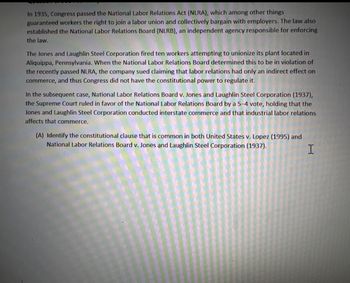Question

Transcribed Image Text:In 1935, Congress passed the National Labor Relations Act (NLRA), which among other things
guaranteed workers the right to join a labor union and collectively bargain with employers. The law also
established the National Labor Relations Board (NLRB), an independent agency responsible for enforcing
the law.
The Jones and Laughlin Steel Corporation fired ten workers attempting to unionize its plant located in
Aliquippa, Pennsylvania. When the National Labor Relations Board determined this to be in violation of
the recently passed NLRA, the company sued claiming that labor relations had only an indirect effect on
commerce, and thus Congress did not have the constitutional power to regulate it.
In the subsequent case, National Labor Relations Board v. Jones and Laughlin Steel Corporation (1937),
the Supreme Court ruled in favor of the National Labor Relations Board by a 5-4 vote, holding that the
Jones and Laughlin Steel Corporation conducted interstate commerce and that industrial labor relations
affects that commerce.
(A) Identify the constitutional clause that is common in both United States v. Lopez (1995) and
National Labor Relations Board v. Jones and Laughlin Steel Corporation (1937).
I
Expert Solution
This question has been solved!
Explore an expertly crafted, step-by-step solution for a thorough understanding of key concepts.
This is a popular solution
Trending nowThis is a popular solution!
Step by stepSolved in 2 steps
